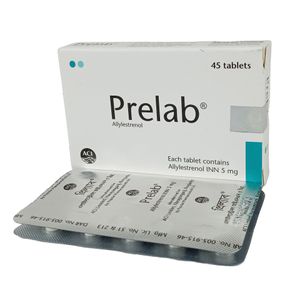Prelab Uses, Dosage, Side Effects and more
Prelab is an orally active gestagen. Prelab has a pronounced pregnancy maintaining action in castrated animals without producing hormonal side-effects. In the human, premature termination of pregnancy often follows a fall in the levels of placental hormones. Prelab has been shown to stimulate the placental progesterone production in vitro & to promote the secretion of placental hormones (human chorionic gonadotrophin, human placental lactogen, oestrogens and progesterone) and oxytocinase in patients with pregnancy at risk. In aggrement to this the trophoblastic layers of the placenta show histological signs of activation. Clinical studies have indicated that Prelab is an effective & safe pregnancy preparation. Administration of Prelab in combination with bed rest can remove or prevent the threat of abortion in early pregnancy or stop threatened premature labor.
Prelab is a progestogen structurally related to progesterone that has been given in threatened and recurrent miscarriage, and to prevent premature labour. However, with the exception of proven progesterone deficiency, such use is no longer recommended. In threatened miscarriage in progesterone-deficient women a suggested dose is 5 mg three times daily by mouth for 5 to 7 days.

| Attribute | Details |
|---|---|
| Trade Name | Prelab |
| Generic | Allylestrenol |
| Allylestrenol Other Names | Alilestrenol, Allilestrenolo, Allyl estrenol, Allylestrenol, Allylestrenolum, Allyloestrenol |
| Weight | 5mg |
| Type | Tablet |
| Formula | C21H32O |
| Weight | Average: 300.4782 Monoisotopic: 300.245315646 |
| Groups | Experimental |
| Therapeutic Class | Female Sex hormones |
| Manufacturer | ACI Limited |
| Available Country | Bangladesh |
| Last Updated: | January 7, 2025 at 1:49 am |
Uses
Prelab is used for -
- - Intra uterine Growth Retardation (IUGR)
- - Threatened abortion
- - Habitual abortion
- - Threatened premature labor
- - Failure of nidation
Prelab is also used to associated treatment for these conditions: Abortions spontaneous, Premature Labour
How Prelab works
Prelab is similar in structure and function to progesterone. Progesterone shares the pharmacological actions of the progestins. Progesterone binds to the progesterone and estrogen receptors. Target cells include the female reproductive tract, the mammary gland, the hypothalamus, and the pituitary. Once bound to the receptor, progestins like Progesterone will slow the frequency of release of gonadotropin releasing hormone (GnRH) from the hypothalamus and blunt the pre-ovulatory LH (luteinizing hormone) surge. In women who have adequate endogenous estrogen, progesterone transforms a proliferative endometrium into a secretory one. Progesterone is essential for the development of decidual tissue and is necessary to increase endometrial receptivity for implantation of an embryo. Once an embryo has been implanted, progesterone acts to maintain the pregnancy. Progesterone also stimulates the growth of mammary alveolar tissue and relaxes uterine smooth muscle. It has little estrogenic and androgenic activity.
Dosage
Prelab should be taken orally. The dose of the drug depends on the indication.
Intra Uterine Growth Retardation [IUGR]: 1 tablet three times a day at least two months. Reduce the dose if symptoms improve.
Threatened Abortion: 1 tablet thrice daily for 5-7 days. The treatment period may be extended depending on necessity. After symptoms disappear, the dosage should be gradually reduced.
Habitual Abortion: 1 to 2 tablets daily with the confirmation of pregnancy. Administration should be continued until at least one month after the critical period.
Threatened Premature Labour: 40 mg daily until symptoms improve.
Failure of Nidation: 2 - 4 tablets daily from 16th to 26th day of the cycle until conception is achieved.
How Long Does It Take to Work?
How Long Does It Take to Work? see here Prelab
Side Effects
Gastrointestinal complaints like nausea, vomiting etc. have been reported.
Precaution
Patients with the following conditions should be cautious: Heart disease, congestive heart failure, sick sinus syndrome, coronary artery disease, seizures, epilepsy, renal dysfunction, migraine headaches, or breathing diseases including asthma, emphysema, chronic bronchitis, or COPD, breast-feeding.
Elimination Route
The glucuronide and sulfate conjugates of pregnanediol and pregnanolone are excreted in the urine and bile. Progesterone metabolites which are excreted in the bile may undergo enterohepatic recycling or may be excreted in the feces. Progesterone metabolites are excreted mainly by the kidneys.
Pregnancy & Breastfeeding use
Prelab is extremely safe. Serious adverse reactions have neither been reported in mother. It is free from anti-ovulatory and androgenic properties. Prelab produces no masculinization of female foetus.
Contraindication
Hypersensitivity; thrombophlebitis; undiagnosed vaginal bleeding, incomplete abortion, hormone-dependent carcinoma, cerebral apoplexy, as a diagnostic test for pregnancy; severe hepatic impairment.
Special Warning
It should not be used for children younger than 16 years old.
Acute Overdose
If you have taken several capsules at once, there is no need for great concern. However, you should consult your doctor. The oily substance in the capsule may cause diarrhea.
Interaction with other Medicine
No drug- drug interactions have been reported.
Storage Condition
- Store in a cool, dry place
- Keep away from light & out of reach of children



